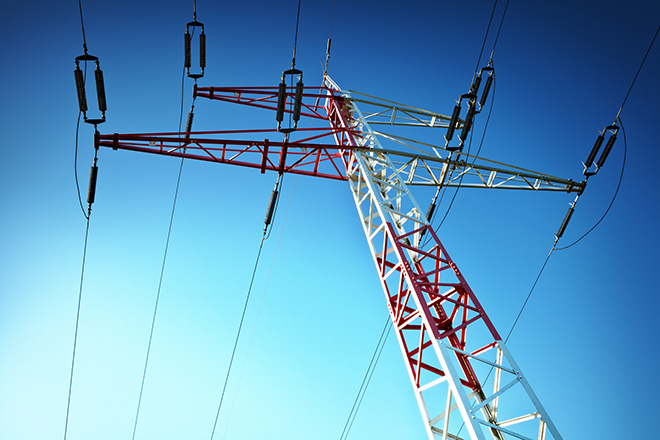S&P Global Offerings
Featured Topics
Featured Products
Events
S&P Global Offerings
Featured Topics
Featured Products
Events
S&P Global Offerings
Featured Topics
Featured Products
Events
Banking & Capital Markets
Economy & Finance
Energy Transition & Sustainability
Technology & Innovation
Podcasts & Newsletters
Banking & Capital Markets
Economy & Finance
Energy Transition & Sustainability
Technology & Innovation
Podcasts & Newsletters
S&P Global Offerings
Featured Topics
Featured Products
Events
10 Aug, 2022

By Zack Hale

|
The U.S. may need to boost its electric transmission capacity by 60% by 2030 to accommodate a surge in clean energy development, according to one estimate. |
The U.S. Senate-passed Inflation Reduction Act is projected to unleash a new wave of clean energy development that gets the nation close to achieving its 2030 climate goals. The measure will also raise the stakes for ongoing policy efforts to expand the U.S. electric transmission system and expedite environmental reviews, according to industry experts.
A Princeton University analysis found that the bill could increase annual utility-scale wind capacity additions from 15 GW in 2020 to 39 GW in 2025-2026 and annual solar capacity additions from 10 GW to 49 GW over the same period.
Those capacity additions, combined with other investments in low- and zero-carbon technologies, would help the U.S. cut economywide emissions by 40% by 2030 relative to 2005 levels — within striking distance of U.S. President Joe Biden's 50%-by-2030 target under the Paris Agreement on climate change.
However, the Princeton University research team noted that it did not model constraints such as the ability to site and permit large-scale infrastructure projects like interregional power lines. A separate analysis by the same researchers found that the U.S. may need to boost its transmission capacity by as much as 60% by 2030 to achieve Biden's broader goal of a net-zero economy by midcentury.
Industry experts noted that the Inflation Reduction Act includes several key transmission-related provisions. But they also said the bill, if signed into law, will make grid expansion efforts at agencies such as the Federal Energy Regulatory Commission even more important.
"Some of the goals that are set forth in legislation, particularly on renewable and clean energy development, are targeting 2030. That's only seven-and-a-half years away," Larry Gasteiger, executive director of the trade association WIRES Group, said in an interview. "If you're talking about getting the infrastructure built to support that level of development, it's got to start happening today."
A question of capital, political will
Notably, the Inflation Reduction Act scrapped a proposed 30% investment tax credit for regionally significant high-voltage transmission lines in the House Democrats' sweeping but never-approved Build Back Better Act.
The Senate-passed Inflation Reduction Act did include a raft of other provisions that could move the needle on a U.S. grid build-out. For instance, the measure would allocate $2 billion to the U.S. Energy Department for loans to help finance transmission lines determined to be in the national interest.
The overall cost of transmission projects supported by that funding could ultimately range between $20 billion and $40 billion, or potentially more, depending on the U.S. Office of Management and Budget's loan cost calculation, said David Hill, former general counsel at the DOE from 2005 to 2009.
A 2005 law directed the DOE to conduct a series of congestion studies and identify national interest electric transmission corridors, but the department eventually shelved those efforts due to legal uncertainty. However, a bipartisan infrastructure law enacted in 2021 clarified the statute.
"The question really comes down to whether DOE and the administration as a whole are willing to exert political will and expend political capital to get something done," Hill said in an email.
The Inflation Reduction Act would give the DOE another $5 billion for loans to support projects that update or repower generation and transmission facilities. Transmission experts have said upgrading and replacing existing power lines with high-voltage direct-current technology is one of the easiest ways to boost U.S. transmission capacity.
The bill would also enable the DOE to disburse $760 million in grant funding to states to help local authorities site transmission lines. Receipt of those funds would be contingent on a siting authority agreeing to reach a final decision on a siting or permitting application within two years.
"It will be interesting to see if this works in actually getting any transmission permitted, approved and built," Hill said, noting that the bill does not reform or change any substantive permitting, siting or eminent domain authorities.
The bill would allocate $100 million to the DOE through 2031 for planning and modeling interregional and offshore wind transmission. "This type of thing is needed and could be really useful," Hill said.
Focus on FERC expected to intensify
The Inflation Reduction Act includes robust incentives for electric vehicle adoption and building electrification, both of which are expected to significantly increase U.S. electricity demand, WIRES' Gasteiger noted.
Even under existing policies, the six-state regional grid operator ISO New England recently said it expects power demand from electrified transport to increase from 38 MW in winter 2022 to 1,535 MW by winter 2031. It also expects demand from heating electrification to increase from 68 MW in 2022 to 1,556 MW in 2031.
"Cumulatively, this is all pointing toward the fact that we're going to need a lot more investment in transmission," Gasteiger said.
That need could place even more pressure on FERC, which has jurisdiction over interstate transmission policy, to issue strong final rules that address transmission planning and cost allocation, generator interconnection reforms, and financial incentives for developers, Gasteiger said.
In April, FERC issued a proposed rule (RM21-17) that would require system operators to plan for expected changes in future generation with a 20-year planning horizon that accounts for federal and state policies. The rule would also require transmission planners to seek buy-in from state regulators.
FERC-jurisdictional system operators such as the Midcontinent ISO recently made major headway by approving a $10.3 billion grid expansion plan. The long-range transmission plan represents the largest portfolio of projects in U.S. history.
But Devin McMackin, manager of federal affairs at transmission developer ITC Holdings Corp., which is active in the MISO region, said in an email that "there is still a lot of work to do."
"We must ensure we use planning models that capture these trends and identify investments that provide the most benefits to customers," McMackin said. "When it comes to transmission planning, we no longer can afford to 'wait and see.'"
In addition, FERC issued a proposed rule (RM22-14) in June that would aim to reduce the number of speculative interconnection requests by imposing more stringent financial requirements on new generation projects. That proposal would also hit transmission providers with the first-ever penalties for missed interconnection study deadlines.
During a recent joint federal-state transmission task force meeting, the commission also heard support for the idea of requiring a minimum level of interregional transfer capacity between balancing areas.
FERC is also still considering a proposed rule (RM20-10) issued in March 2020 that would shift financial incentives for new transmission projects away from its traditional risk-based approach. Instead, the proposal would reward projects that offer reliability and economic benefits.
"I think [the Inflation Reduction Act] really bolsters the case for strong commission action and will ultimately really bolster the case for the final rules that the commission ultimately gets to in those proceedings," Jeff Dennis, general counsel for the trade group Advanced Energy Economy, said in an interview.
Permitting reform up next?
With the House expected to vote Aug. 12 on the Inflation Reduction Act, the focus is now turning to a separate framework agreement on permitting reform between U.S. Sen. Joe Manchin, D-W.Va., and Democratic leadership.
The proposed reforms would seek to expedite high-priority electric transmission projects as well as natural gas infrastructure, according to a one-page summary.
The agreement would give the DOE secretary the ability to designate national interest electric transmission corridors and would empower FERC to issue construction permits for projects sited in those areas. It would also authorize FERC to approve utility payments to communities affected by a power line's construction and set a maximum limit of two years for reviews of major projects under the National Environmental Policy Act.
The chances of permitting reform passing in the U.S. Congress remain unclear due to the politically sensitive nature of the proposed reforms. Lawmakers are expected to attach the permitting package to a funding bill that must pass by Sept. 30 to keep the government running.
"Drafting the right statutory language and getting agreement on it will be tough — and everything will depend on getting that language just right," Hill said. "But in terms of the concepts, some of what is in this list could be pretty consequential if done the right way."
S&P Global Commodity Insights produces content for distribution on S&P Capital IQ Pro.
